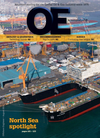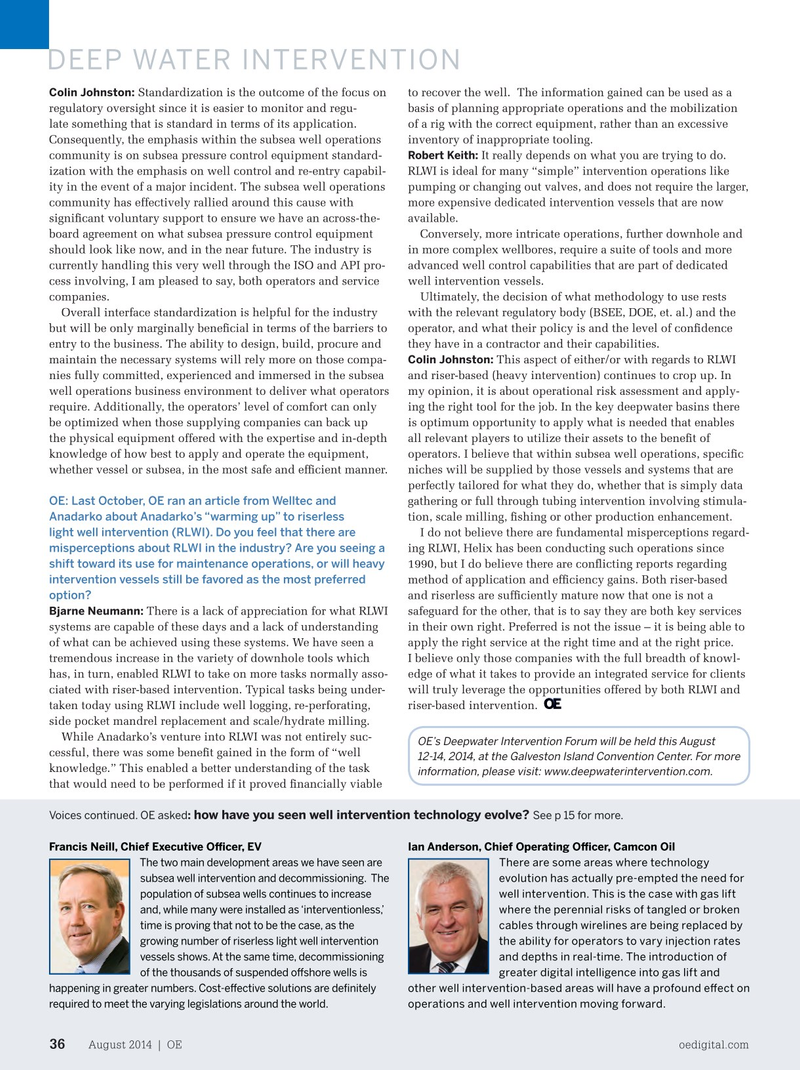
Page 34: of Offshore Engineer Magazine (Aug/Sep 2014)
Read this page in Pdf, Flash or Html5 edition of Aug/Sep 2014 Offshore Engineer Magazine
DEEP WATER INTERVENTION
Colin Johnston: Standardization is the outcome of the focus on to recover the well. The information gained can be used as a regulatory oversight since it is easier to monitor and regu- basis of planning appropriate operations and the mobilization late something that is standard in terms of its application. of a rig with the correct equipment, rather than an excessive
Consequently, the emphasis within the subsea well operations inventory of inappropriate tooling.
Robert Keith: It really depends on what you are trying to do. community is on subsea pressure control equipment standard-
RLWI is ideal for many “simple” intervention operations like ization with the emphasis on well control and re-entry capabil- pumping or changing out valves, and does not require the larger, ity in the event of a major incident. The subsea well operations more expensive dedicated intervention vessels that are now community has effectively rallied around this cause with available.
signifcant voluntary support to ensure we have an across-the- board agreement on what subsea pressure control equipment Conversely, more intricate operations, further downhole and should look like now, and in the near future. The industry is in more complex wellbores, require a suite of tools and more currently handling this very well through the ISO and API pro- advanced well control capabilities that are part of dedicated cess involving, I am pleased to say, both operators and service well intervention vessels.
companies. Ultimately, the decision of what methodology to use rests
Overall interface standardization is helpful for the industry with the relevant regulatory body (BSEE, DOE, et. al.) and the but will be only marginally benefcial in terms of the barriers to operator, and what their policy is and the level of confdence entry to the business. The ability to design, build, procure and they have in a contractor and their capabilities.
Colin Johnston: maintain the necessary systems will rely more on those compa- This aspect of either/or with regards to RLWI nies fully committed, experienced and immersed in the subsea and riser-based (heavy intervention) continues to crop up. In well operations business environment to deliver what operators my opinion, it is about operational risk assessment and apply- require. Additionally, the operators’ level of comfort can only ing the right tool for the job. In the key deepwater basins there be optimized when those supplying companies can back up is optimum opportunity to apply what is needed that enables the physical equipment offered with the expertise and in-depth all relevant players to utilize their assets to the beneft of knowledge of how best to apply and operate the equipment, operators. I believe that within subsea well operations, specifc whether vessel or subsea, in the most safe and effcient manner. niches will be supplied by those vessels and systems that are perfectly tailored for what they do, whether that is simply data
OE: Last October, OE ran an article from Welltec and gathering or full through tubing intervention involving stimula-
Anadarko about Anadarko’s “warming up” to riserless tion, scale milling, fshing or other production enhancement. light well intervention (RLWI). Do you feel that there are I do not believe there are fundamental misperceptions regard- misperceptions about RLWI in the industry? Are you seeing a ing RLWI, Helix has been conducting such operations since shift toward its use for maintenance operations, or will heavy 1990, but I do believe there are conficting reports regarding intervention vessels still be favored as the most preferred method of application and effciency gains. Both riser-based option? and riserless are suffciently mature now that one is not a
There is a lack of appreciation for what RLWI safeguard for the other, that is to say they are both key services
Bjarne Neumann: systems are capable of these days and a lack of understanding in their own right. Preferred is not the issue – it is being able to of what can be achieved using these systems. We have seen a apply the right service at the right time and at the right price. tremendous increase in the variety of downhole tools which I believe only those companies with the full breadth of knowl- has, in turn, enabled RLWI to take on more tasks normally asso- edge of what it takes to provide an integrated service for clients ciated with riser-based intervention. Typical tasks being under- will truly leverage the opportunities offered by both RLWI and taken today using RLWI include well logging, re-perforating, riser-based intervention. side pocket mandrel replacement and scale/hydrate milling.
While Anadarko’s venture into RLWI was not entirely suc-
OE’s Deepwater Intervention Forum will be held this August cessful, there was some beneft gained in the form of “well 12-14, 2014, at the Galveston Island Convention Center. For more knowledge.” This enabled a better understanding of the task information, please visit: www.deepwaterintervention.com.
that would need to be performed if it proved fnancially viable
Voices continued. OE asked: See p 15 for more.how have you seen well intervention technology evolve?
Francis Neill, Chief Executive Ofcer, EV Ian Anderson, Chief Operating Ofcer, Camcon Oil
The two main development areas we have seen are There are some areas where technology subsea well intervention and decommissioning. The evolution has actually pre-empted the need for population of subsea wells continues to increase well intervention. This is the case with gas lift where the perennial risks of tangled or broken and, while many were installed as ‘interventionless,’ time is proving that not to be the case, as the cables through wirelines are being replaced by growing number of riserless light well intervention the ability for operators to vary injection rates and depths in real-time. The introduction of vessels shows. At the same time, decommissioning of the thousands of suspended ofshore wells is greater digital intelligence into gas lift and happening in greater numbers. Cost-efective solutions are defnitely other well intervention-based areas will have a profound efect on operations and well intervention moving forward.
required to meet the varying legislations around the world.
August 2014 | OE oedigital.com 36 032_OE0814_DWI1_DIF roundtable.indd 36 7/22/14 9:08 PM

 33
33

 35
35